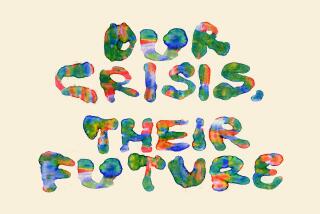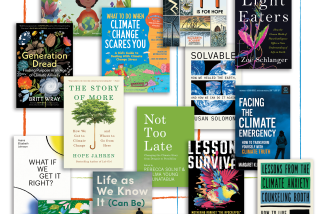Eco books for kids: Saving the planet, one book at a time
The environmental movement may not yet have changed the world, but it has certainly changed the world of children’s books. Hardly a science or nature book for kids fails to sound a warning about habitats, species and resources in danger. Where 10 years ago an author described a hibernating bear fast asleep, in a recent book, “Life in the Boreal Forest,” we read: “The bear snoozes under a fallen tree, but his sleep is restless. Chip, chop! Now that the soggy ground is frozen, a logging crew is cutting trees. Each year brings new loggers, miners, and peat harvesters. The boreal forest is disappearing fast.”
Fiction shares these concerns. Carl Hiaasen has practically made a new career in writing child-heroes as environmental activists in his trio of young-adult novels (for ages 9-12), “Hoot” (Yearling: $6.99 paper) (about endangered owls), “Flush” (Knopf: $16.95) (on the illegal dumping of raw sewage into the ocean) and “Scat” (Knopf: $16.99) (about panthers disappearing from the Florida Everglades). In books like “Operation Redwood” (Amulet: $16.95, ages 8-12) and “Fern Verdant and the Silver Rose” (Knopf: $15.99, ages 9-12) rapacious developers and industrialists take the place of villains who callously used humans for their own ends.
Cormac McCarthy, in his grim but utterly compelling book “The Road,” offers the image of handing a ruined world over to our children and hoping that the tiny spark of humanity we’ve planted in them will somehow continue to shine. This is perhaps a more realistic vision than all the cheery suggestions of “50 Simple Things You Can Do to Save the Earth.” Recycle, change your light bulbs, eat less meat, and carpool; does that about cover it? It’s clear we aren’t making even these simple changes fast enough.
However, the least we can do is to refrain from passing on our helpless hysteria to our kids. Kids don’t need indoctrination; they’ll draw their own conclusions soon enough. A parent’s job is to give children the confidence to face things about which we don’t yet have a clue. And among the components of confidence are hope and imagination, which are much more effectively fostered by good books than by well-intentioned ones.
In science, the best children’s books about environmental awareness aren’t making a case for anything; they just assume environmental science is an exciting field. My favorite is Loree Griffin Burns’ “Tracking Trash: Flotsam, Jetsam, and the Science of Ocean Motion” (Houghton Mifflin: $18, ages 9-12): This is where I first learned about the Great Pacific Garbage Patch, of mankind’s utter inability to dispose properly of plastics.
Blake Nelson is a novelist who specializes in smart but confused teen boy heroes, the kind you know will be OK if they can just catch a break. He captures the grand visions and the generalized irritation of teen idealism in “Destroy All Cars” (Scholastic: $17.99, ages 14 and up). The book opens with James’ homework assignment to write a “four-page persuasive essay.” His passionate argument for abandoning cars earns a C-plus and the comment: “too emotional and not supported by facts . . . calling people names is not an effective way to sway them to your point of view.” In the course of this wonderful novel, James’ ideals are put to the test by his longing for a beautiful girl who collects signatures on do-good petitions and might be impressed if James could take her out in a cool car. Altogether, James’ consideration of “the lameness of people in general” -- which he fairly applies also to himself -- gives a nuanced look at why it’s hard to change anything in the world but also why it’s a noble cause worth striving for.
For younger children, the picture book “The Curious Garden” by Peter Brown (Little Brown: $16.99, ages 3-6) offers the same encouragement in an equally imaginative way. Liam, a boy who lives in a dull, industrial landscape, comes across a patch of green and immediately sees his path as a gardener. He has a lot to learn about caring for plants, but he and the plants seem to teach each other. Gradually the garden grows as Liam’s skills grow; together, they move out into the city, finding small, forgotten areas to colonize. The illustrations subtly convey that these things take time -- Liam grows old over the course of the book -- but that good ideas gather followers and nature is always there, waiting to work with us.
“Camping With the President” by Ginger Wadsworth, illustrated by Karen Dugan (Calkins Creek/Boyds Mills Press: $16.95, age 8 and up) tells the story of how Theodore Roosevelt, during his presidency, spent several days camping in the Sierras with the famous naturalist John Muir. Roosevelt’s celebrated enthusiasm easily carries over the intervening 100 years to persuade readers how precious solitude and natural beauty are -- even if you don’t have to ditch a battalion of Secret Service men to get it.
Perhaps the most mind-bending recent book on the subject is “Redwoods” by Jason Chin (A Neal Porter Book/Roaring Brook Press: $16.95, ages 4-8). Simple, as the best ideas are, Chin’s book appears to be a straightforward account of the facts about Sequoia sempervirens -- the coast redwood tree. A boy waiting for a subway train finds a book -- the very book the reader is holding in his hands -- lying on the bench next to him. As he enters the train and begins reading about how ancient the redwoods are, dinosaurs appear outside the window, and a fully armed Roman soldier peers over his shoulder. Emerging at his subway stop into a dense forest, the boy is almost sideswiped by a car speeding by, illustrating the fact that “a redwood trunk can be 29 feet in diameter . . . a tunnel can be cut in it, big enough for a car to drive through.” The story in the illustrations shows in lovely metaphor how a tiny seed of information can take root in a fertile mind and grow into a strong, fire- and disease-resistant, redwood-sized understanding.
Bolle’s Word Play column appears at www.latimes.com/books.
More to Read
The biggest entertainment stories
Get our big stories about Hollywood, film, television, music, arts, culture and more right in your inbox as soon as they publish.
You may occasionally receive promotional content from the Los Angeles Times.










